EPISODE 3: MILWAUKEE TO NIAGARA FALLS
At the end of Episode 2 I mentioned my disappointment in not being able to see the Johnson Wax building in Racine but this was somewhat lessened by my visit to the very impressive new art museum in Milwaukee designed by Spanish architect and engineer (he builds spectacular bridges too) Santiago Calatrava. Here are some pictures including one with a sculpture by Jacques Lipschitz who was born in Lithuania (one of the most famous Litvaks). The walkway leading to the entrance is rather strange with room for only one person at a time. The last picture is the Seattle connection I mentioned earlier. I told one of the people working there that I didn’t come all the way from Seattle to see a Chihuly and told her about the bumper sticker: “Recycle Chilhuys”
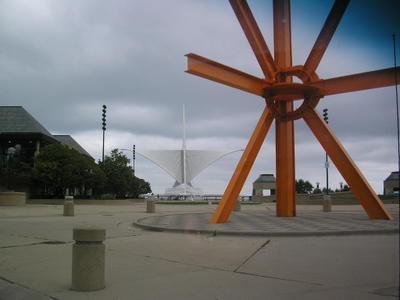
Milwaukee Museum

Museum 2

Milwaukee Museum
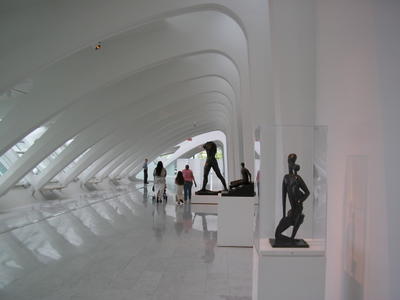
Lipschitz

Chilhuly
That night I went to a game between the Brewers and Cincinnati. Miller Park is a little strange with four relatively narrow decks – the first three have luxury boxes behind the relatively few rows of seats in each deck. And it is relatively vertical, like an enclosed coliseum. It was a really wild game that lasted almost 4 hours; the Brewers scored five runs in the bottom of the eighth to win12-9 after the Reds scored two in the top of the eighth to take the lead. Although I had to drive to Green Bay after the game to make an appointment to have my car serviced I did not want to leave early (as I never do) especially since I committed the mortal sin of missing the first part of the game. I was sitting in the parking lot making cell phone calls (another mortal sin) because I thought the game started at 7:30 instead of 6:30. I forgot the schedule I downloaded from the ESPN webpage has all the games in Eastern, not Central time. I was able to get a really good seat, 15 rows up from the Brewers dugout, for only $5 from a guy who was not going to the game. The guy sitting next to me volunteered the information about what each batter did in the top of the first, which I missed, so I could complete my scorecard. BTW, keeping score in National League games is a real challenge what with the double switches and all. Unfortunately, this will be the only game I get to see as the regular season is coming to an end. But Cooperstown is on the agenda. Plus a possible surprise in Nanticoke PA.

Chilhuly
After Green Bay I drove up to Michigan’s Upper Peninsula (The UP). I drove through the Hiawatha national Forest but I have no idea where the shores of Gitche Gumee are. One interesting place is on the Fayette Peninsula – a preservation of an old tin mining town. All these structures, except the last one, are original. In the last picture of the reconstructed little workers’ cabin you can just make out the rest of the Fayette Peninsula in the background. This looks like part of the same geologic formation as the Door County peninsula that comes up from Wisconsin.
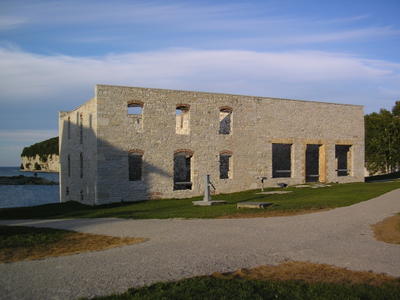
Fayette 1
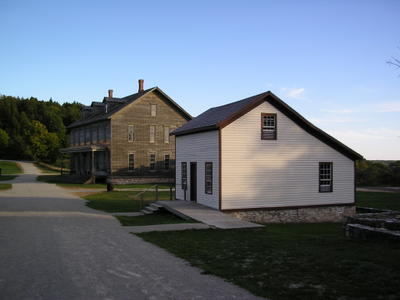
Fayette 2

Worker's Cabin
I also visited an oft-photographed lighthouse at Seul Choix point – this means only choice in French and was seen as a refuge from the bad weather on Lake Michigan. Here are my photos including one of the light from the tower.

Seul Choix Lighthouse
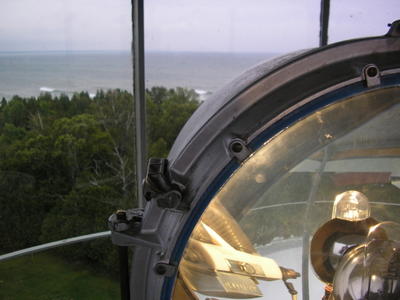
See the light
I took a ferry to Mackinac Island (pronounced Mackinaw), one of the major historic tourist destinations of the Midwest. The best thing about the place is that there are no automobiles allowed. Also, they are very famous for their fudge. John Jacob Astor started his fur empire here. Here is a picture of the Grand Hotel with the world’s largest balcony. The ferry ride cost $19 which was not too bad but everything else on the island cost extra – it would have cost me $10 to visit this balcony. The next picture is of some Victorian houses that were first constructed as very modest homes but were then expanded to go along with the new Grand Hotel that was constructed about the same time - 1887. I did not take the horse-drawn carriage tour of the island – for one thing it cost another $18, and for another thing I refuse to take part in any activity where my presence will lower the average age of the participants. I did take a several mile walk around the island, however, careful not to step in the ubiquitous leavings of the substitutes for automobiles. (Note the topiary horses in the picture of the hotel – this is a theme that will be taken up again later on in the trip in South Carolina.)

Grand Hotel
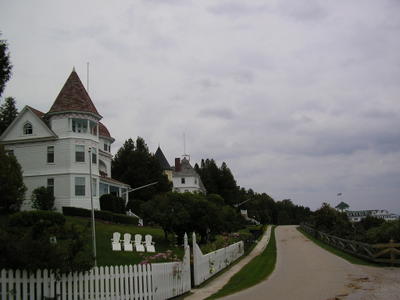
Mackinac houses
After taking the ferry back to St Ignace (pronounced IG-nus) I drove across the largest suspension bridge in the western hemisphere to reach Michigan’s lower peninsula. I was lucky because earlier in the day there was a severe wind warning that mentioned small pickup trucks with cabs on them as being most vulnerable. But I made it across without incident. And the bridge and the city are spelled as it is pronounced, I have no idea why.

Mackinaw Bridge
Now back to the World War II aspect of this trip. I went on to Detroit where I visited two people who are central to my discovery, over the past 6 years, of my father’s story on D-Day. Here are Mark Bando and George Koskimaki and then George and me.

Mark and George
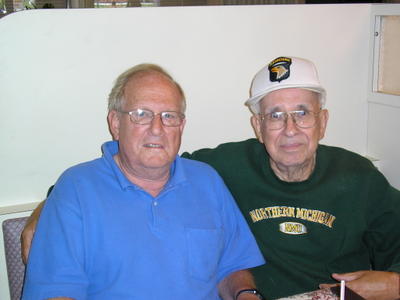
George and me
George, on the right, was the radio operator for General Maxwell Taylor (later to be big in the Kennedy administration and ambassador to Viet Nam) throughout the war. Taylor was commander of the 101st Airborne Division – the 501st Paratroop Infantry Regiment was part of the 101st. He took part in the assault on Pouppeville too, where my dad was killed. It was unusual for such big brass (Division HQ) to take part in such an operation but the paratroopers had been scattered all over Normandy so they made do with what they could assemble. In fact, Taylor was quoted as saying, “Never have so many been led by so few.”
About 20 years after the war Koskimaki decided to write a book about D-Day, in part to correct some of the wrong information in other history books. The book is called D-Day with the Screaming Eagles. The best thing about the book is his collection of quotations from the paratroopers themselves. George is a very warm person and he still gets emotional when talking about these men. In this book are the first quotations of men who were with my dad when he was killed and describe how it happened.
This information was later taken up by Mark Bando, the other very interesting person in this story, who has written several books on the 101st in Normandy and later on in the war. When I first got in contact with him I assumed that he was a veteran himself and was Italian, like the old A’s third baseman, Sal Bando. But instead he is one generation younger. He got interested in the 101st when he did a high school paper on the subject and interviewed a former paratrooper that lived in his Detroit neighborhood. He was the first Asian-American on the Detroit police force. He is now retired and devotes all his time to his passion of writing about the paratroopers and collecting memorabilia. He also has a website and he included my father in one of his first “Lest We Forget” items and has included pictures of my dad in one of his books. (http://www.amazon.com/exec/obidos/tg/detail/-/0760308551/qid=1128442775/sr=8-1/ref=pd_bbs_1/103-7494638-2095826?v=glance&s=books&n=507846)
Here are some pictures of Mark and his collection in his home. His major objective is collecting patches and I have given him a rare one from my father that he did not have. The trooper he is pictured next to in the second picture is dressed just as the troops did that jumped into Normandy on D-Day.
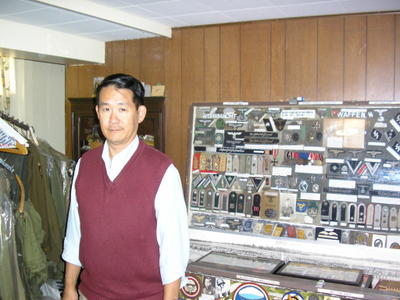
Mark and part of his collection
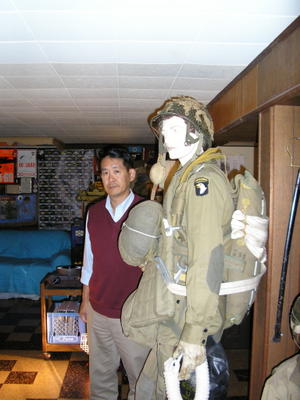
D-Day Trooper
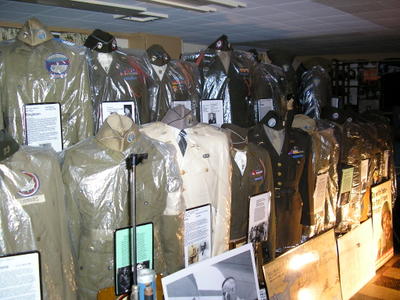
More of Mark's collection
At lunch Mark and George discussed a veteran, Richard Evans, who was in the same Company G (a subdivision of the 501st Regiment) as my father and who lives in the Detroit area but has never participated in any reunion activities and certainly does not participate in the Lunch Bunch comprised of WWII history buffs that meet every month in the Detroit. Mark and George were not sure why Evans has been so reticent. Mark visited him once about four years ago but Evans did not want to discuss things very much. In fact, Evans lives about ten minutes drive from Mark’s house. Mark thought that he might be willing to meet if Lt. Marks’ son showed up at his door, so we just drove over there (his phone number is unlisted).
We knocked on the door and at first it seemed that nobody was home, but finally a man did answer. Mark introduced himself and Evans did remember him from last time, and then introduced me. Evans remembered my father and, in fact, said that he recalled that he was very skinny. This reminded me of the very first time I met anyone who knew my father at the first reunion I went to in 1999 and Wilbur Ingals said, Your father was tall and skinny. I said, thanks a lot. I guess sometimes genes don’t will out.
In any case we had a nice discussion with Evans. He did not remember that much about Lt Marks as the officers and enlisted men did not fraternize at all but said he got along OK with all the officers. He was not in my fathers platoon (a further subdivision of Company G). He said that he just did not want to deal with the war and its memories once it was over. He kept in Christmas card contact with several of his buddies but had no desire to attend any reunions and discuss old war stories. He worked for a couple of years after the war for Alcoa and then got sick of the dusty work conditions and started delivering mail which he did the rest of his working life. His wife had just died last week after several years suffering from Alzheimer’s. Mark borrowed a couple of photos to copy and made his usual attempt to purchase some of the few medals and patches that Evans has in a glass case, but those are to go to his daughters when he dies.
Before this day I did not even know Evans existed, yet in the picture I showed before he was standing just behind and one man to the right of my father. Here that picture is again, and then one taken the day of my visit about sixty-two years later. When we left he was not sure exactly what to call me, and I said Cliff, of course. He said that if he ever called my father by his first name the response would have been an immediate, Get down and give me 25 NOW.
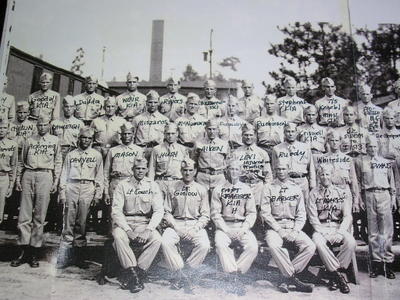
Marks and Evans at Camp Mackall
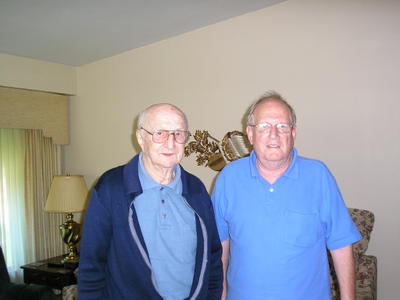
Evans and Marks
After I left Detroit I passed through Canadian customs as I entered Ontario. The Canadian official asked me where I was going and I told him, Niagara Falls. He asked me why I was going there and I told him (I couldn’t help it) that that was once of the silliest questions I ever heard. He did not get too upset and after I told him that my father was born in Winnipeg he cheered up a bit and let me through.
Driving through the southern part of Ontario I saw a sign for the Jumbo Monument in St. Thomas. I was intrigued because one of my high school history teachers, and also a good friend of the family as he was also a teaching colleague of my mother, had written a children’s book about this famous elephant. I knew that he was stuffed and resides at Tufts University in Boston (the elephant, not my friend the history teacher), so I was curious about what this monument was all about. It turns out to be a life size stature commemorating the fact that a train ran into and killed Jumbo when he was working for the circus and on the road in this part of Canada. Here is the big guy:
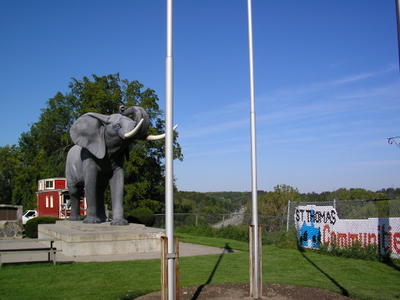
Jumbo
After I visited the Taj Mahal I mentioned that few things live up to expectations but the Taj was one thing that certainly did. I have to say the same thing about Niagara Falls. In fact, I was surprised how much I enjoyed the experience. Sometimes a super-cliché turns out not to be a cliché at all (PBS). I had always wanted to go there and was very excided about the prospect, but the experience itself was incredible. The falls are just amazing. People talk about the Snoqualmie Falls being taller. That is such a joke. Height is not an issue. The sheer size and magnitude (those words may mean the same thing) of Niagara is just spectacular. I seem to have heard somewhere, and I am not sure if it is true, that twenty percent of the world’s fresh water passes over these falls.
In any case, here are my pictures including one of and one from the Maid of the Mist boat ride. I had always wanted to go on that ride and, again, was thrilled by the experience. The ride only cost thirteen dollars and yet it cost twelve dollars to park in the falls area. Go figure.
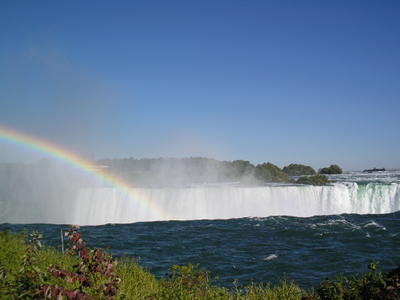
Niagara Falls 1
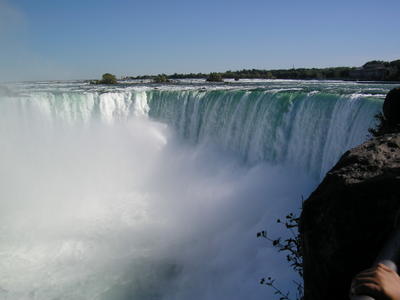
Niagara 2
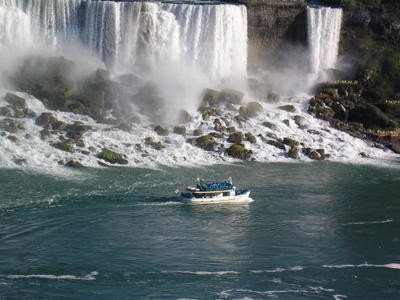
Maid of the Mist
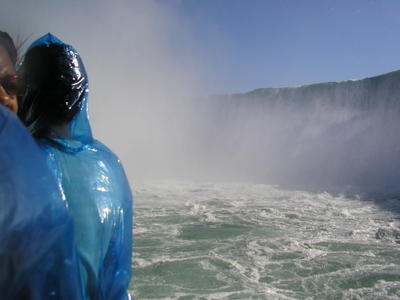
From the Maid
On the way to Niagara Falls I drove a little out of the way to catch a small glimpse of Lake Ontario to the north. Niagara River flows from Lake Erie (and thus drains four of the great lakes) to the north into Lake Ontario and passes the falls on the way. I wanted to complete the HOMES great lakes part of my trip. I saw a bit of Superior from the ridge above Duluth, lots of Michigan from Milwaukee and around the UP, Mackinac Island is actually in Huron, and I drove along the north side of Erie on the way from Detroit to Niagara.

0 Comments:
Post a Comment
<< Home